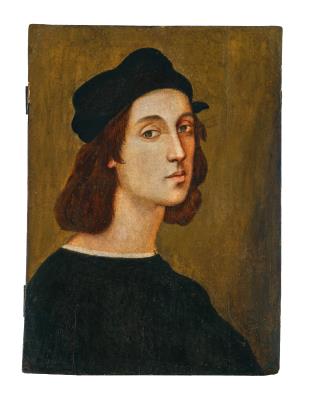Follower of Raffaello Sanzio, called Raphael
Portrait of the artist as a young man,
oil on panel, 46 x 34 cm, framed
Provenance:
Anna Maria Papi (1928–2012), Germany;
where acquired by the father of the present owner in the 1980s;
Private collection, Hungary
The present painting relates to Raphael’s Self-portrait as a young man in the Palatine Gallery, Pitti Palace, Florence (inv. 1890 no. 1706).
This painting can also be compared to another self-portrait of the artist in the fresco depicting the School of Athens in the Stanza della Segnatura in the Vatican, commissioned by Pope Julius II and painted between 1509 and 1511. In both portraits the artist portrays himself with a similar expression and features. The cut of his hair is typical of a court page of the Renaissance and his dark cap, in the style later known as ‘raffaella’, is of the kind used by painters, as is his dark robe, from which a white shirt is barely visible underneath. He is wearing simple working attire in an intentional allusion to his trade. His graceful features appear to confirm the enthusiastic judgement given by Vasari praising Raphael’s ‘grace, study, beauty and excellent clothes’ and his perfection as an artist, comparing him to that of the painters Zeuxis and Apelles, remembered as the greatest painters of the classical world.
The original version was conserved in Urbino, Raphael’s city of birth, where it was located until 1652, in the apartments of Vittoria della Rovere, daughter of the last Duke of Urbino and Claudia de’ Medici. The fact that the lords of Urbino would have wanted the effigy of Raphael in their collection is plausible: as a successful painter, Rapahel was a source of great pride and glory for the city in which he had been born. In the 1630s, Vittoria della Rovere, betrothed to her cousin Ferdinando II de’ Medici, brought the finest masterpieces of her family’s collection to Florence as her dowry. The self-portrait was then registered (1663–1667) as one of the ‘Portraits of painters painted by their own hand’ collected by Cardinal Leopoldo de’ Medici, the first nucleus of his extensive collection which is now mostly in the Uffizi, Florence.
Esperto: Mark MacDonnell
 Mark MacDonnell
Mark MacDonnell
+43 1 515 60 403
oldmasters@dorotheum.com
25.10.2023 - 18:00
- Stima:
-
EUR 40.000,- a EUR 50.000,-
Osserva lotto Non osservare più
Follower of Raffaello Sanzio, called Raphael
Portrait of the artist as a young man,
oil on panel, 46 x 34 cm, framed
Provenance:
Anna Maria Papi (1928–2012), Germany;
where acquired by the father of the present owner in the 1980s;
Private collection, Hungary
The present painting relates to Raphael’s Self-portrait as a young man in the Palatine Gallery, Pitti Palace, Florence (inv. 1890 no. 1706).
This painting can also be compared to another self-portrait of the artist in the fresco depicting the School of Athens in the Stanza della Segnatura in the Vatican, commissioned by Pope Julius II and painted between 1509 and 1511. In both portraits the artist portrays himself with a similar expression and features. The cut of his hair is typical of a court page of the Renaissance and his dark cap, in the style later known as ‘raffaella’, is of the kind used by painters, as is his dark robe, from which a white shirt is barely visible underneath. He is wearing simple working attire in an intentional allusion to his trade. His graceful features appear to confirm the enthusiastic judgement given by Vasari praising Raphael’s ‘grace, study, beauty and excellent clothes’ and his perfection as an artist, comparing him to that of the painters Zeuxis and Apelles, remembered as the greatest painters of the classical world.
The original version was conserved in Urbino, Raphael’s city of birth, where it was located until 1652, in the apartments of Vittoria della Rovere, daughter of the last Duke of Urbino and Claudia de’ Medici. The fact that the lords of Urbino would have wanted the effigy of Raphael in their collection is plausible: as a successful painter, Rapahel was a source of great pride and glory for the city in which he had been born. In the 1630s, Vittoria della Rovere, betrothed to her cousin Ferdinando II de’ Medici, brought the finest masterpieces of her family’s collection to Florence as her dowry. The self-portrait was then registered (1663–1667) as one of the ‘Portraits of painters painted by their own hand’ collected by Cardinal Leopoldo de’ Medici, the first nucleus of his extensive collection which is now mostly in the Uffizi, Florence.
Esperto: Mark MacDonnell
 Mark MacDonnell
Mark MacDonnell
+43 1 515 60 403
oldmasters@dorotheum.com
|
Hotline dell'acquirente
lun-ven: 10.00 - 17.00
old.masters@dorotheum.at +43 1 515 60 403 |
| Asta: | Dipinti antichi |
| Tipo d'asta: | Asta in sala con Live Bidding |
| Data: | 25.10.2023 - 18:00 |
| Luogo dell'asta: | Wien | Palais Dorotheum |
| Esposizione: | 14.10. - 25.10.2023 |

